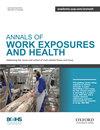175 发动机排放气溶胶的特征
IF 1.8
4区 医学
Q3 PUBLIC, ENVIRONMENTAL & OCCUPATIONAL HEALTH
引用次数: 0
摘要
电机在电风扇、电吹风、清洁机器人和电动剃须刀等家用电器中起着至关重要的作用。然而,多项研究表明,吸尘器和玩具车等家用电器内部的电机会产生超细粒子,而这些粒子已被证实对人体健康有害。因此,我们将测试颗粒数量浓度和颗粒大小,了解电机产生颗粒的主要机制。我们将建立一个容积为 2 升的实验箱。将测试电机置于实验箱内,并向实验箱内提供不含颗粒的空气,以产生颗粒。我们使用冷凝式粒子计数器和扫描移动式粒子测定仪来监测粒子浓度和粒径范围。我们将使用室内常用的有刷直流电机和额定输出功率为 64 W 的无刷直流电机进行测试。机制经验结果表明,电刷和轴承都会通过机械摩擦产生微粒,而通过火花放电产生的微粒数量是通过机械摩擦产生的微粒数量的 100 倍。这表明火花放电是电机产生微粒的主要机制。在转速约为 10,000 RPM 时,颗粒排放率高达 3.4 x 107 #/sec。然而,在 10,000 RPM 时,无刷直流电机的颗粒排放率仅为 2.2 x 104 #/sec,约为有刷直流电机的千分之一。本文章由计算机程序翻译,如有差异,请以英文原文为准。
175 The characteristic of aerosol emission from motors
A motor plays a crucial role in household appliances, such as fans, hair driers, cleaning robots and electric shavers. However, varies studies have showed that the motors inside the household appliances, such as vacuum cleaners and toy cars, generate the ultrafine particle, which have been proven to be harmful to human health. So, we will test the particle number concentration and particle size, and know about the main mechanisms by which motors generate particles. Ultimately, find an effective way to control motor-generated particles We establish an experimental chamber with a volume of 2 liters. Test motor would be placed inside the chamber, and the chamber were supplied with particle free air to bring out the particles. We use a Condensation Particle Counter and a Scanning Mobility Particle Sizer to monitor the particulate concentration and particle size range over time. A brushed DC motor and a brushless DC motor with a rated output power of 64 W commonly used indoors, will be utilized for testing. The results of mechanism experience indicate that both the brushes and the bearings generate particles through mechanical friction, and the particles generated through spark discharge are 100 times more numerous than those generated through mechanical friction. This suggests that spark discharge is the main mechanism for particle generation by the motor. At a rotational speed of approximately 10,000 RPM, the particle emission rate reaches as high as 3.4 x 107 #/sec.However, at 10,000 RPM, the particle emission rate of the brushless DC motor is only 2.2 x104 #/sec, about one-thousandth that of the brushed DC motor.
求助全文
通过发布文献求助,成功后即可免费获取论文全文。
去求助
来源期刊

Annals Of Work Exposures and Health
Medicine-Public Health, Environmental and Occupational Health
CiteScore
4.60
自引率
19.20%
发文量
79
期刊介绍:
About the Journal
Annals of Work Exposures and Health is dedicated to presenting advances in exposure science supporting the recognition, quantification, and control of exposures at work, and epidemiological studies on their effects on human health and well-being. A key question we apply to submission is, "Is this paper going to help readers better understand, quantify, and control conditions at work that adversely or positively affect health and well-being?"
We are interested in high quality scientific research addressing:
the quantification of work exposures, including chemical, biological, physical, biomechanical, and psychosocial, and the elements of work organization giving rise to such exposures;
the relationship between these exposures and the acute and chronic health consequences for those exposed and their families and communities;
populations at special risk of work-related exposures including women, under-represented minorities, immigrants, and other vulnerable groups such as temporary, contingent and informal sector workers;
the effectiveness of interventions addressing exposure and risk including production technologies, work process engineering, and personal protective systems;
policies and management approaches to reduce risk and improve health and well-being among workers, their families or communities;
methodologies and mechanisms that underlie the quantification and/or control of exposure and risk.
There is heavy pressure on space in the journal, and the above interests mean that we do not usually publish papers that simply report local conditions without generalizable results. We are also unlikely to publish reports on human health and well-being without information on the work exposure characteristics giving rise to the effects. We particularly welcome contributions from scientists based in, or addressing conditions in, developing economies that fall within the above scope.
 求助内容:
求助内容: 应助结果提醒方式:
应助结果提醒方式:


